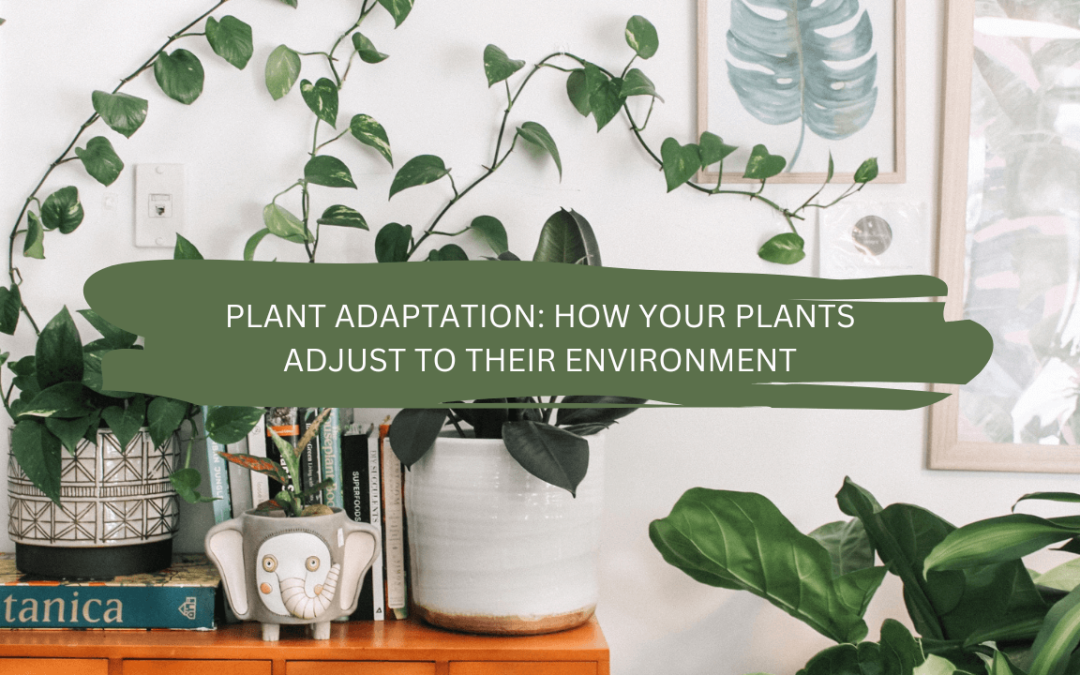Plants exhibit remarkable adaptability to their environments through natural selection and evolution. Plant adaptation involves modifying structures, processes, and behaviors to thrive in diverse conditions, including variations in temperature, light, water, and nutrients. For instance, desert plants have evolved water-conserving features, while shade-dwelling plants elongate stems for more light.
Plant adaptation extends to interactions with other organisms, with specialized relationships for pollination and nutrient enhancement. This process occurs over generations, influenced by environmental changes like climate shifts.
Understanding plant adaptation informs our choices in selecting, planting, and caring for trees. Recognizing species-specific adaptations allows for informed decisions, contributing to successful vegetation in various landscapes. Plant adaptation showcases the resilience and versatility of these organisms, enriching green spaces in harmony with nature.
Importance of plant adaptation

Plant adaptation is crucial for plant resilience and success, particularly in arboriculture. Plants have evolved diverse strategies to thrive in challenging environments, enduring factors like drought and extreme temperatures. These adaptations enable plants to persist in varied habitats, contributing to their distribution and ecosystem diversity.
Plant adaptation is essential for colonizing new habitats and interacting with other organisms. Understanding these adaptations has practical implications in conservation and agriculture. In arboriculture, recognizing plant adaptive mechanisms informs decisions in species selection and management practices, promoting resilient landscapes.
In conclusion, plant adaptation is a fundamental aspect of plant biology with practical implications, influencing plant survival, distribution, and ecosystem interactions. Appreciating these adaptations empowers to make informed choices, fostering sustainable practices for cultivated and natural plant communities.
Types of Plant Adaptation
Morphological adaptation, in plant biology, refers to physical modifications enhancing a plant’s ability to thrive in specific environments. Encounter diverse examples of these adaptations in their work.
Examples of Morphological Adaptations:
- Root Systems: Some plants develop extensive root systems with fine root hairs for efficient nutrient absorption from nutrient-poor soils.
- Thorns and Spines: Certain plants have thorns or spines as defense mechanisms, deterring herbivores from feeding on foliage or stems.
Importance of Morphological Adaptation:
- Efficient Resource Acquisition: Adaptations aid in resource-efficient acquisition, crucial for growth in challenging conditions.
- Defense Mechanisms: Thorns and spines act as deterrents, reducing herbivory and safeguarding plant foliage.
- Internal Environment Regulation: Adaptations help regulate internal environments, optimizing physiological processes and withstanding stresses.
Tip: Understanding these adaptations is vital for effective plant care. Use this knowledge to select suitable species, implement proper pruning techniques, and ensure the overall health of trees and shrubs.
Physiological Adaptation
Physiological adaptation, in the context of plants, involves intricate biochemical changes to cope with environmental stresses. Regularly encounter these adaptations, crucial for plant survival.
Examples of Physiological Adaptations:
- Stress Hormones: Plants produce hormones like abscisic acid (ABA) in response to stress, regulating growth and conserving energy.
- Protective Compounds: Synthesis of antioxidants and osmoprotectants shield plants from extreme temperatures and drought, preserving cellular integrity.
Importance:
- Essential Functions: Physiological adaptations allow plants to maintain crucial functions during environmental stress, redirecting resources for survival and growth.
- Protective Role: Synthesized compounds protect plants from harmful effects, ensuring continued physiological functioning in challenging conditions.
- Water Regulation: Plants regulate water uptake and transpiration, vital for water balance and survival in arid regions or droughts.
Behavioral Adaptation
Behavioral adaptation in plants involves adjusting growth, development, and reproductive behaviors based on environmental cues, optimizing survival and reproduction.
Examples of Behavioral Adaptations:
- Flowering Timing: Plants synchronize reproduction with favorable conditions, flowering when pollinators are abundant.
- Growth Patterns: Plants exhibit phototropism (growing towards light) and gravitropism (orienting growth in relation to gravity) to optimize resource utilization.
- Resource Allocation: Plants allocate resources based on nutrient availability, prioritizing growth in nutrient-rich areas.
Importance:
- Reproductive Success: Behavioral adaptations ensure optimal timing for flowering and seed production, enhancing reproductive success.
- Resource Utilization: Growth patterns optimize resource acquisition, with phototropism maximizing photosynthetic capacity and gravitropism aiding nutrient absorption.
- Resource Allocation Flexibility: Plants adapt resource allocation to thrive in varying nutrient conditions, enhancing resilience in challenging environments.
Factors Affecting Plant Adaptation

Climate significantly influences plant adaptation, shaping strategies for temperature, moisture, and light conditions. For instance, desert plants exhibit water-storing features like succulent stems, while arctic plants adopt compact growth forms to combat cold and low light.
Soil characteristics play a vital role, with plants developing specialized roots for different types, pH levels, and nutrient contents. Deep roots thrive in nutrient-poor soils, while shallow roots focus on nutrient-rich ones. Adaptations also extend to pH tolerance, enabling efficient nutrient uptake within preferred ranges.
Water availability is crucial for plant health, leading to adaptations like waxy coatings for water conservation in arid environments and specialized roots for oxygen uptake in waterlogged soils.
Light influences plant selection and management, with adaptations such as larger leaves for low-light conditions and protective pigments in high-light environments.
Biological Factors
Competition among plants for essential resources is crucial for adaptation. Robust root systems, including deep-reaching roots, provide a competitive advantage by accessing water and nutrients beyond neighbors’ reach. Allelopathy, releasing inhibitory compounds, is another strategy, suppressing nearby plant growth and ensuring a competitive edge.
Defense mechanisms against predation involve toxin production, thorns, spines, and physical barriers to deter herbivores and pathogens. These adaptations act as protective shields, reducing the risk of damage or infection.
Symbiotic relationships, like mycorrhizal fungi and nitrogen-fixing bacteria, enhance plant adaptation. Fungi improve nutrient uptake, while bacteria provide access to essential nutrients, fostering resilience and thriving in diverse environments.
In conclusion, understanding these biological factors guides effective plant care, promoting successful adaptation and long-term survival.
Examples of Plant Adaptation

Desert plants showcase impressive morphological and physiological adaptations to thrive in harsh arid conditions. Recognizing these adaptations is vital for effective plant care. Notable examples include succulent leaves and stems for water storage during infrequent rainfall, deep roots accessing groundwater, and thick waxy cuticles reducing water loss through transpiration. Some plants employ CAM photosynthesis, a unique adaptation that minimizes water loss. These remarkable features enable desert plants to endure drought and succeed in water-scarce environments. Understanding and appreciating these adaptations guide informed decisions in caring for desert plants and creating landscapes that emulate their natural habitat.
Alpine Plants
In high-elevation environments, alpine plants display remarkable adaptations that captivate us. Their ability to withstand extreme cold, low-light, and nutrient-poor conditions is truly impressive. Notable adaptations include small leaves and stems, minimizing heat loss; trichomes on leaves to trap warm air and shield against winds; deep roots accessing nutrients in deeper soils; and anthocyanin pigments protecting against intense sunlight. Recognizing these adaptations helps guide our care for alpine plants in gardens or landscapes, ensuring conditions that mimic their natural habitat and promote their resilience.
Aquatic Plants
Appreciating the adaptations of aquatic plants is key to understanding their thriving in water environments. Notable examples include large-leaved surface areas for efficient photosynthesis despite water challenges, air-filled spaces in stems and leaves ensuring buoyancy, and specialized root structures like rhizomes or floating lilies for stability and nutrient uptake. Additionally, their high-efficiency photosynthesis compensates for limited light penetration in water. Recognizing these adaptations guides us in caring for aquatic plants in gardens, ponds, or water features, promoting their health and vitality in their unique habitats.
Carnivorous Plants
Appreciating the unique adaptations of carnivorous plants is essential for understanding how they thrive in nutrient-deficient habitats. Notable examples include modified leaves forming various traps to capture prey and the production of enzymes for prey digestion. Carnivorous plants efficiently absorb and utilize nutrients from prey, supplementing their nutrient requirements in challenging environments. It’s crucial to recognize the balance between prey nutrients and photosynthesis, with the latter remaining essential for energy production. Studying these adaptations enriches our understanding of plant diversity, contributing to plant conservation and sustainable agriculture practices.
Importance of Plant Adaptation
Recognizing the vital role of plant adaptation in ecosystems is crucial for understanding their balance and functionality. Plants have evolved diverse adaptations for efficient resource competition, optimizing water, nutrients, and sunlight utilization. These adaptations contribute to overall ecosystem productivity by ensuring the effective distribution of resources among plant species.
Plant adaptations also support herbivores and pollinators, fostering a balanced relationship. Through features like nectar production and colorful flowers, plants attract pollinators, aiding in pollination and seed production. Meanwhile, adaptations like toxin production deter excessive herbivory, maintaining equilibrium in the herbivore-plant dynamic.
Furthermore, plants provide essential ecosystem services, capturing carbon through photosynthesis, cycling nutrients, and regulating local climate conditions. Recognizing the role of trees and plants in providing these services emphasizes the importance of conserving and sustainably managing plant communities for the overall health and resilience of ecosystems.
Agriculture
Recognizing the importance of plant adaptation is key to sustainable agriculture. Farmers can make informed decisions by understanding how crops adapt to environmental conditions. This knowledge contributes to sustainable agriculture in several ways:
- Selection of Appropriate Crop Varieties: Farmers can choose crop varieties that suit local climate and soil conditions, enhancing crop establishment and growth. This informed selection leads to higher yields and improved agricultural productivity.
- Resource Optimization: Plant adaptation knowledge helps farmers optimize water, fertilizer, and pesticide use. Selecting varieties with efficient water-use strategies or resistance to pests minimizes resource inputs, promoting sustainable resource management and reducing environmental impact.
- Resilience to Climate Change: Understanding plant adaptation is crucial in the face of climate change. Farmers can mitigate risks by selecting varieties resilient to changing climatic conditions, ensuring productivity in regions prone to water scarcity or extreme temperatures.
- Conservation of Genetic Diversity: Plant adaptation understanding encourages the conservation of genetic diversity within crop species. Preserving diverse crop varieties safeguards genetic resources for future breeding and crop improvement efforts, addressing potential agricultural challenges.
In conclusion, embracing plant adaptation knowledge empowers farmers to cultivate crops suited to their locations, promoting sustainable food production and reducing environmental impact in agriculture.
Conservation
Recognizing the critical role of plant adaptation in conservation is essential for effective plant preservation. Here’s how plant adaptation contributes to conservation:
- Species Identification and Prioritization: Studying plant adaptations helps identify vulnerable species, allowing conservationists to prioritize efforts and allocate resources for the protection of threatened plants.
- Habitat Restoration and Management: Understanding plant adaptation guides the selection of species for ecosystem restoration, enhancing recovery in degraded habitats. Conservationists choose plants with adaptive traits suitable for specific environmental conditions.
- Climate Change Resilience: In the face of climate change, plant adaptation knowledge aids in identifying species resilient to changing conditions. Conservation strategies can focus on safeguarding these adaptive species through protected areas, assisted migration, and habitat corridors.
- Education and Awareness: Plant adaptation serves as a tool for public education, raising awareness about the diversity and significance of plants. Highlighting unique adaptations inspires support for conservation initiatives and informed decision-making.
In conclusion, leveraging knowledge of plant adaptations is crucial for conservation efforts, enabling the identification of vulnerable species, habitat restoration, climate resilience, and public engagement in plant preservation. This understanding contributes to the protection and longevity of plant species for the well-being of our planet.
Human Health
Recognizing the vital role of plant adaptation is crucial for cultivating, conservating, and utilizing medicinal plants. Here’s a concise version:
The adaptations of medicinal plants to specific environments are essential for sustainable practices and human health. Understanding these adaptations enables the cultivation and harvesting of medicinal plants in environmentally friendly ways. It also facilitates effective utilization by extracting active compounds for medicinal purposes.
Conservation efforts are guided by insights into plant adaptations, protecting critical habitats and ensuring long-term sustainability. Promote sustainable practices, educating stakeholders to conserve biodiversity, protect ecosystems, and ensure the availability of medicinal plants for future generations. This understanding contributes to the overall well-being of our environment and society.
Conclusion
In exploring the realm of plant adaptation, we delve into a world where the resilience and ingenuity of flora are vividly displayed. The journey through various ecosystems—from the arid deserts where cacti store water in their thickened stems, to the lush rainforests where orchids exhibit remarkable versatility—reveals the profound adaptability of plants. These adaptations are not mere curiosities; they are vital responses to the challenges posed by their environments. Plants, through their ability to adapt, demonstrate an evolutionary narrative that is both dynamic and intricate.
This narrative is increasingly influenced by human activities and climate change. Urban environments and altered climates are not just new backdrops but active agents in the evolutionary story of plant life. Plants that once thrived in stable environments now face the rapid onset of change, prompting accelerated adaptation or, in some cases, the risk of extinction. Understanding these adaptations goes beyond academic interest—it’s a crucial step in preserving biodiversity and maintaining the ecological balance.
Moreover, the study of plant adaptation offers insights into our own relationship with the natural world. It highlights the interconnectedness of life and the delicate balance that sustains ecosystems. As we face environmental challenges, learning from the adaptability of plants can inspire solutions for sustainable living and conservation efforts. In essence, the study of plant adaptation is not just about understanding plants; it’s about understanding life itself and our place within it.
FAQ About Plant Adaptation
Plants adapt to varying light conditions through leaf size, orientation, and chlorophyll concentration changes. In low light, they often grow larger leaves with more chlorophyll to maximize light absorption, while in intense light, they may develop smaller, thicker leaves to reduce water loss and prevent damage.
Yes, plants can adapt to dry environments. For instance, succulents store water in their leaves and stems, while some plants develop deep root systems to access water from deeper soil layers. Others have small, waxy leaves to minimize water loss.
In cold climates, plants may develop adaptations like antifreeze proteins to prevent cell damage from freezing, smaller leaf size to reduce heat loss, and dark pigmentation to absorb more solar heat. Some plants also enter a dormancy period during winter.
Aquatic plants often have flexible stems and leaves to withstand water currents, air-filled tissues for buoyancy, and specialized root systems for water and nutrient absorption. Some may also have leaves that float on the water’s surface for sunlight exposure.

